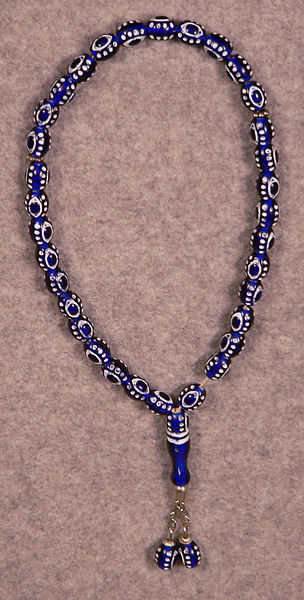Prayer beads are a form of beadwork used to count the repetitions of prayers, chants, or mantras by members of various religions such as Hinduism, Buddhism, Shinto, Umbanda, Islam, Sikhism, the Baháʼí Faith, and some Christian denominations, such as the Roman Catholic Church, the Lutheran Church, the Oriental Orthodox Churches, and the Eastern Orthodox Churches. Common forms of beaded devotion include the mequteria in Oriental Orthodox Christianity, the chotki or komposkini or prayer rope in Eastern Orthodox Christianity, the Wreath of Christ in Lutheran Christianity, the Dominican rosary of the Blessed Virgin Mary in Roman Catholic Christianity, the dhikr in Islam, the japamala in Buddhism and Hinduism, and the Jaap Sahib in Sikhism.
The image depicts several Christian prayer beads; from left to right are a Roman Catholic Dominican rosary, a Lutheran Wreath of Christ, a set of Anglican prayer beads, a Western Christian Pater Noster cord, and a Coptic Orthodox mequteria.
A misbaha, a device used for counting tasbih
Anglican prayer beads
Oriental Orthodox mequteria of 41 beads
Beadwork is the art or craft of attaching beads to one another by stringing them onto a thread or thin wire with a sewing or beading needle or sewing them to cloth. Beads are produced in a diverse range of materials, shapes, and sizes, and vary by the kind of art produced. Most often, beadwork is a form of personal adornment, but it also commonly makes up other artworks.
Ukrainian bead weaving pysanka
Beadwork in progress on a bead weaving loom. Black, orange and transparent seed beads are being used to make a bracelet.
A string of blue faience beads from north Lisht, a village in the Memphite region of Egypt, c. 1802–1450 B.C.
King Charles II and Catherine of Braganza with allegories of the four continents, a elaborate beadwork basket project








